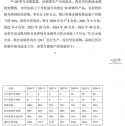Absolutely. Material Science is one half art (trial and error) and half science.That is more or less correct China weakness is material science well science is misnomer since it is more or less trial and error and incremental improvement over time See the first stage turbine blade will experience extreme temperature.
Additionally, the first stage (the stage directly following the combustor) of a modern gas turbine faces temperatures around 2,500 °F (1,370 °C), up from temperatures around 1,500 °F (820 °C) in early gas turbines. Modern military jet engines, like the Snecma M88, can see turbine temperatures of 2,900 °F (1,590 °C).
At that temperature most metal will melt So the only metal that can withstand that temperature is Titanium but it bring their own problem of difficult to manufacture So you need Metal alloy but to do that you need exotic metal and single growth crystal couple with air cooling (drilling hole in the blade which itself bring problem since it weaken the blade unless done perfectly)
Only recently China master the technology You can create good blade on lab but when it was installed on real engine it got problem so continuing improvement over time just like any combustion engine That is why only old industrial country like Germany, French and Japan master the technology. Anyway China now master the technology Here is the planned production of WS 10 from security exchange filling.
Another thing is organizational. In the past it was fragmented and poorly funded with Engine design traditionally design by each aircraft institute and China give the appearance of late because they design engine and aircraft at the same time legacy of Soviet style integrated company. Normally engine take a long time to perfect averaging 2 decades sometime 3 decades for civilian engine. In the western practice the engine and aircraft manufacturer are separate and the engine is done first before the aircraft separate funding and design team. China now follow this practice with formation of AECC with large funding and strong independent organization and R&D
The WS-10, which powers the J-10, J-11, J-15, J-16 fighters is having a successful production run. The company sees gradual increase in annual production numbers starting from 320 engines in 2020 till 450 engines by 2026.
You are using an out of date browser. It may not display this or other websites correctly.
You should upgrade or use an alternative browser.
You should upgrade or use an alternative browser.
Chinese Engine Development
- Thread starter jackbh
- Start date
I remember for when the table surfaced on cjdby in 2019, prior to Covid 19, people already question about those number was only part of the production, not the whole.The WS-10, which powers the J-10, J-11, J-15, J-16 fighters is having a successful production run. The company sees gradual increase in annual production numbers starting from 320 engines in 2020 till 450 engines by 2026.
We can now exam these number in Feb 2021, let's assume most WS-10 is used by twin-engine jets, that means China only produces 30 flankers + J-20 in 2020, and 5 J-10C in 2020, do you really think this is a reasonable estimation for all the WS-10 production before the Covid 19 outbreak?
Moreover, even with the impact of Covid 19, I think the actual production of new flankers is more than 30 in 2020, plus we know there were at least two batches of J-20 delivered in 2020.
especially given what we just know that
there were about 50 WS-10s (28? J-10C + 7+ J-20 in the picture) delivered by CAC in the 2nd half of 2020.This is from a fairly authoritative source. He thinks the photo (of many J-10s) was taken sometime in December because the grass is turning brown. He also mentions that he visited Chengdu in November and didn't see that many planes there. He says that December is the time when manufacturers burns the midnight oil on deliveries so that it's not unusual to see many planes parked outside. This has nothing to do with engine problems. He also attached an image he took on his November visit (second image below) where not many planes were visible outside.


If 65 is the total WS-10 production, that means SAC only produces less than 10 flankers in 2020???
recent news suggested that CAC got an AVIC production accomplishment award 2020 at the end of Dec, but the fact was that SAC got the same award in Sep... thus I would imagine SAC use much more WS-10 than CAC last year
Hendrik_2000
Lieutenant General
I remember for when the table surfaced on cjdby in 2019, prior to Covid 19, people already question about those number was only part of the production, not the whole.
We can now exam these number in Feb 2021, let's assume most WS-10 is used by twin-engine jets, that means China only produces 30 flankers + J-20 in 2020, and 5 J-10C in 2020, do you really think this is a reasonable estimation for all the WS-10 production before the Covid 19 outbreak?
Moreover, even with the impact of Covid 19, I think the actual production of new flankers is more than 30 in 2020, plus we know there were at least two batches of J-20 delivered in 2020.
especially given what we just know that
there were about 50 WS-10s (28? J-10C + 7+ J-20 in the picture) delivered by CAC in the 2nd half of 2020.
If 65 is the total WS-10 production, that means SAC only produces less than 10 flankers in 2020???
plus another news that could add up to the argument was that last year CAC got its AVIC production accomplishment award 2020 at the end of Dec, but SAC got that award in Sep... I would imagine SAC use much more WS-10 than CAC last year
I don't understand your math It says production run for 2020 is 320 engine. Assuming 20 engines for spare that leave 300 engines for production of aircraft . Assuming 60 J 10C production that still leave 240 engine for J 16, J 15 and other that is a lot of engine
where does it say 320 engines in 2020 in that picture? although this number does make much more senseI don't understand your math It says production run for 2020 is 320 engine. Assuming 20 engines for spare that leave 300 engines for production of aircraft . Assuming 60 J 10C production that still leave 240 engine for J 16, J 15 and other that is a lot of engine
It doesn't the article from which the image was linked claims this section is about what it calls the WZ-10 engine (?). The WS-10 image is a little above it, this is the WS-10 chartwhere does it say 320 engines in 2020 in that picture? although this number does make much more sense

Note that this is from the same series of images where the WS-15 chart implying production of ~5 engines per year until 2025 is from which was the origin of a lot of debate a couple months back. Also the images are from a stock report from Hebei subsidiary of China’s Central Iron & Steel Research (CISRI) so none of the engine design institutes, which made these figures a subject of great speculation.
yes, I also record that debate vividly, nobody doubt the truth of the report, as it came from the annual report, but many people questioned if they are the only supplier of the WS-15 engine. It is extremely likely that they were only asked to supply 5 units in the next few years.It doesn't the article from which the image was linked claims this section is about what it calls the WZ-10 engine (?). The WS-10 image is a little above it, this is the WS-10 chart
View attachment 68617
Note that this is from the same series of images where the WS-15 chart implying production of ~5 engines per year until 2025 is from which was the origin of a lot of debate a couple months back. Also the images are from a stock report from Hebei subsidiary of China’s Central Iron & Steel Research (CISRI) so none of the engine design institutes, which made these figures a subject of great speculation.
far as I understand, engine development in most phase is more like a cosumable supplies, if only 5 unit per year, that means ws-15 is still at least about 10 year from being ready
Last edited:
I think it is right to question it, as WS-20 numbers in the same report raise similar questions.yes, I also record that debate vividly, nobody doubt the truth of the report, as it came from the annual report, but many people questioned if they are the only supplier of the WS-15 engine. It is extremely likely that they were only asked to supply 5 units in the next few years.

According to the table above, 2020 to 2021 production for WS-20 is 8 units each year. 2022 6 units and 2023 4 units.
This appears to be a very low number, and doesn't really align with the observation that Y-20 has already switched to using WS-20 engines in late 2020. Each Y-20 requires 4 engines, so if the above table represents the full product quantity of WS-20, we would only be seeing at most the following quantity of WS-20 powered Y-20 production:
- 2 in 2020
- 2 in 2021
- 1 in 2022
- 1 in 2023
How likely is that? Therefore I don't believe WS-20 numbers in the above table represent the full production.
And if WS-20 numbers do not represent full production numbers, what confidence do we have in WS-10, WS-15, and WS-19 numbers representing the full production?
Putting a different hat on, thinking from the perspective of a military top brass,
1. Would I allow any contractor to disclose the true production number of one of the most sensitive/secret engines powering one of the most secretive weapon?
2. Would I use an annual company report for disinformation, knowing that people would have inherent trust?
The fact that these numbers are published in an annual company report, means they are worthless (or only for disinformation).
@Gatekeeper
Another way of looking at it is that the latest Chinese engines have about 80-90% of the performance of the latest US/European engines.
So yes, it's manageable for military aircraft
Another way of looking at it is that the latest Chinese engines have about 80-90% of the performance of the latest US/European engines.
So yes, it's manageable for military aircraft
that's right, don't know why people keep referring to these number as it might be validI think it is right to question it, as WS-20 numbers in the same report raise similar questions.
View attachment 68631
According to the table above, 2020 to 2021 production for WS-20 is 8 units each year. 2022 6 units and 2023 4 units.
This appears to be a very low number, and doesn't really align with the observation that Y-20 has already switched to using WS-20 engines in late 2020. Each Y-20 requires 4 engines, so if the above table represents the full product quantity of WS-20, we would only be seeing at most the following quantity of WS-20 powered Y-20 production:
- 2 in 2020
- 2 in 2021
- 1 in 2022
- 1 in 2023
How likely is that? Therefore I don't believe WS-20 numbers in the above table represent the full production.
And if WS-20 numbers do not represent full production numbers, what confidence do we have in WS-10, WS-15, and WS-19 numbers representing the full production?
Putting a different hat on, thinking from the perspective of a military top brass,
1. Would I allow any contractor to disclose the true production number of one of the most sensitive/secret engines powering one of the most secretive weapon?
2. Would I use an annual company report for disinformation, knowing that people would have inherent trust?
The fact that these numbers are published in an annual company report, means they are worthless (or only for disinformation).
Hendrik_2000
Lieutenant General
Well it is production from one supplier There might be other supplier say SOE that has minimal private participation They might not need security filling. So figure from one company only tell part of the story It can be more and not less Security filling is serious business lying is not an option. You will barred from stock marketthat's right, don't know why people keep referring to these number as it might be valid
